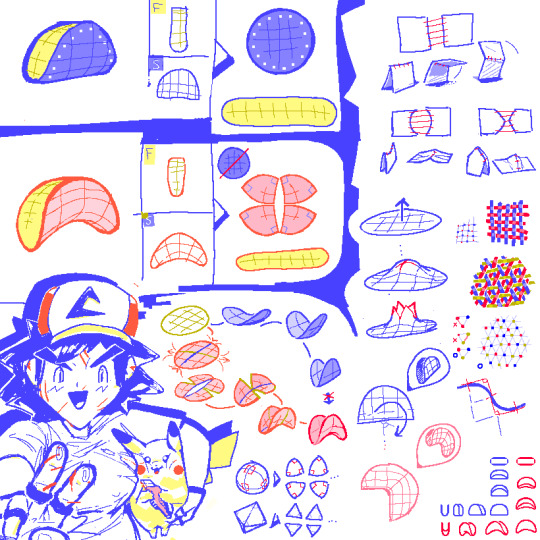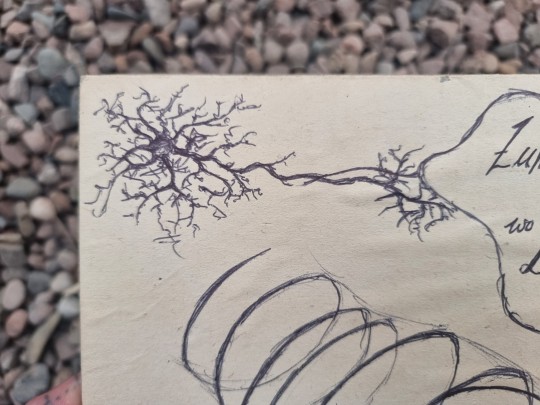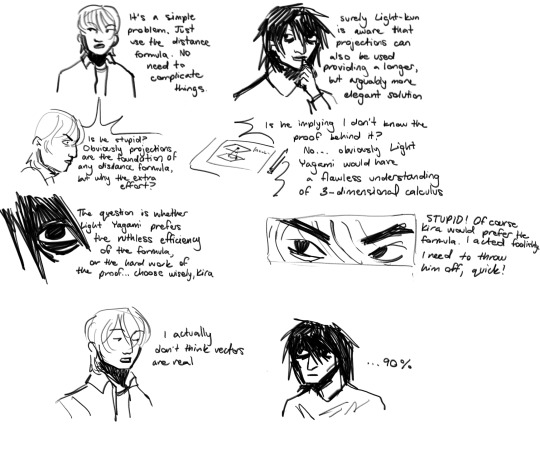#hyperbolic paraboloid
Explore tagged Tumblr posts
Text

differences between paraboloids
10 notes
·
View notes
Text
The shape of Pringles is called a hyperbolic paraboloid
In calculus, a hyperbolic paraboloid is a doubly-curved surface that resembles the shape of a saddle. This shape makes it easier to stack the chips and minimises the possibility of breaking during transport. Due to its saddle shape, there is no predictable way to break it up, which apparently increases that crunchy feeling.
8 notes
·
View notes
Text

Day 18: Saddle
Behold, the poorly drawn hyperbolic paraboloid.
It will be hard to beat this thing as the worst inktober drawing, look at the typo oof. But let's wait until partial exams begin next week, it could (and will likely) get worse.
9 notes
·
View notes
Text



"Home is where love is"
Knotty's art from ~a week ago. [2023/08/17]
#art#my art#surreal#home is where love is#love#home#neuron#hyperbolic paraboloid#surrealism#surreal art#ballpoint pen#knotty et al#knottys art#axon
5 notes
·
View notes
Note
hyperbolic paraboloid
You draw hats so well and im like so amazed by it because every time i try it looks like they're wearing buckets?? how do you draw them?? :o


pringles
62K notes
·
View notes
Text
This is one of the best projects that I have come across this year. Everything about it is just fantastic. Kudos to all involved.
"The building is laid out on an 8 by 8m structural grid arrayed into a 7,700m footprint housing 50 stalls. An ingenious vaulted roofing structure spans across the market only interrupted by two green courtyards at its heart. The inverted umbrellas shape a hyperbolic paraboloid roofing system; this not only reflects our dedication to form-finding for architectural aesthetics and structural integrity but also integrates a biophilic design philosophy, seamlessly blending the structure with its natural surroundings."
0 notes
Text


finally doing my own “put light yagami in real life situations”. his drawing of a hyperbolic paraboloid is flawless
#acclimated to new ipad by drawing what i know best. trying to like solidify my character designs#this is my academic rivals au light and L are competitors for valedictorian and light is suspected of running an anonymous gossip account#death note#light yagami#l lawliet#misa amane#kiyomi takada#calculus#death note meme#my art#my art 2024#comic#featuring: |ax+by+cz+d|/sqrt(a^2+b^2+c^2)
94 notes
·
View notes
Text


Ulrich Müther (1934-2007), structural engineer and entrepreneur, created some of the former GDR’s most striking buildings, immediately recognizable due to their characteristic hyperbolic paraboloid roof construction. But despite Müther’s significance many of his buildings have been demolished or fallen into neglect. A turning point in this development was the demolition of the restaurant „Ahornblatt“ in Berlin’s Mitte district in 2000: ignoring the heritage status of the building this significant Müther structure was demolished by ruthless developers. This incident led to ample criticism and authorities subsequently were better aware of the historic meaning of Müther buildings. Tanja Seeböck’s monograph „Schwünge in Beton - Die Schalenbauten von Ulrich Müther“, published in 2016 by Thomas Helms Verlag, is the first in-depth scientific monograph on Müther and offers an all-encompassing account of the engineer’s life and work. After an introduction to the principles of shell constructions Seeböck examines the particularities and principles of Müther as well as the somewhat difficult relation between architect and engineer in the former GDR. But it is two chapters of the book that stand out as especially important: the extensive reception history of the engineer’s constructions and the detailed work catalogue (the first of its kind) in the back of the book. These two parts are of particular importance for the future protection of Müther buildings because they demonstrate the importance of his designs within the built heritage of the former GDR and at the same time remind us of the significant number of buildings already gone. Above all it should also be noted that the monograph is extensively illustrated, very well-written and therefore far from being a dry scientific publication. Chapeau!
#ulrich müther#monograph#architecture#gdr#germany#nachkriegsmoderne#nachkriegsarchitektur#architecture book#architectural history#ddr
24 notes
·
View notes
Text
rereading my old wizard school textbooks atm and forgot how much math there was
why is there vectors and 3-space in my magic??? why are there hyperbolic paraboloids and ellipsoids here?? i apparently have to learn all these different ways to construct my apertures in case i need to be creative??
but all apertures are is a way to shape a spell differently than what the textbook says. Who makes a fireball that isn't a fire BALL??
4 notes
·
View notes
Text
Yarn Log - Mini Hyperbolic Paraboloid


Background & Thoughts
After my experience doing the coaster in a single day, I again felt like doing just a tiny crochet project that I could speed through. I’ve always wanted to do one of the hyperbolic plane curly guys, but searching on Ravelry only turned up paid patterns or ones that were technically hosted on other sites. The app on my phone I use to actually hold the patterns I’m working on (knitCompanion) can only automatically import free Ravelry downloads, so I opted for this instead.
A hyperbolic paraboloid is the mathematical name for the kind of saddle shaped surface that you may recognize as the Pringles shape. As a former math major I think they’re pretty cool, and it seemed like a good substitute for the actual hyperbolic plane I was searching for. Plus, it was a really small project, so I could once again bang it out start to finish in a single day.
Once again, I used my 4.25mm crochet hook, but this time I used the medium weight yarn I had left over from The Blanket™ (post still incoming! I just am queuing up a few smaller yarn logs in the mean time lol). The only new maneuver in the pattern was the sc2tog, which was pretty easy to google and execute.

Something you may notice in the above picture is that my result barely resembles the target shape lol. I can think of a few explanations for this, all relating to yarn tension:
I generally messed up the yarn tension, which I already know I need to work on (see yesterday’s coaster post)
I improperly handled the sc2tog’s as the mirror reverse of the doubled-up sc stitches (to increase the stitch count back up on the latter half). This may have caused the weird curling
What is certainly clear though, is that I used the wrong size of crochet hook. Looking at another small roll of the same yarn in a different color that I’ve yet to take off the packaging for, it recommends using a 5mm crochet hook for the medium weight yarn. This means that using the hook itself to measure my gauge as I was working resulted in it being too tight, which also likely combined with the sc2tog and general yarn tension issues to produce this outcome.
UPDATE ON LAST POINT SINCE I FIRST DRAFTED THIS: I did it again with the yarn I used for the coaster (which seemed the right weight for the hook size), and the shape is still bogus. So while I still think the hook size was an issue, at this point I think either it’s a flaw in the pattern itself, or the same general tension issue from the tiny swatch I made with the coaster. Not including a pic of that, bc it’s basically the same just slightly smaller and purple.
Since this piece is not meant to lie flat, I am unable to block it into a better shape. So I’m just accepting it as it is lol
Major lessons learned:
I need to continue working on my yarn tension problems before working on a bigger project. My hyperfixation-specific perfectionism-triggered affective disorder would easily undermine any triumphs I’d make if the tension is messed up on a project I care more about, and I don’t want to set myself up for avoidable depression lol.
I need to obtain a more complete set of crochet needles. I have a good set of smaller ones, but after my bookmark experience, no way in hell will I be using the tiny-ass weighted yarn that would be appropriate for those. This 4.25mm is what I carry in my active projects bag to handle mistakes and to fasten the outside tail of when I make center-pull yarn balls. It worked with the yarn weight I used yesterday for the coaster, but I don’t have a lot left of that kind. My next hook size up is 6.5mm, for heftier yarn weights. So if I want to be crocheting with the yarn weights I commonly have on hand, I really am gonna have to invest in different sizes. Bleh, money. I have since made the purchase and am waiting for it to arrive.
Sometimes it seems, pattern makers will not tell you explicitly to do the turning stitch when going to the next row. This hasn't really been an issue for me since, due to me working in a spiral ever since then, but I have gotten a lot more observant about stitch counts when reading patterns.
Pattern
4 notes
·
View notes
Text
youtube
I lost track of how many times "hyperbolic paraboloid" was said
also: 1960s tractor supply company jump scare out the window at 6:27
3 notes
·
View notes
Text
I could go for some hyperbolic paraboloids right about now.
5 notes
·
View notes
Text
Mediafire Full Discog Links to My Music Archive Release Now
2 notes
·
View notes
Note
yeah. like. curved in both directions at once. akin to a hyperbolic paraboloid. universally negative gauss curvature
...Okay.
5 notes
·
View notes
Text

Day 162 — Parking Garage III
The South Lawn car park is an underground parking garage at the University of Melbourne constructed in 1971–72 using reinforced concrete shells with parabolic profiles supported on short columns designed by Jan van der Molen, an engineer.
The columns encase pipes to drain the soils above for the planting of lawn and trees of the South Lawn. Van der Molen's design of sophisticated hyperbolic-paraboloidal platforms, was described as …saucer-shaped flowerpots on columns, interconnected to form arches. The deep dishes of the concrete forms allowed large trees to be planted on its roof.
Photo: 2025
Day 103 — Parking Garage II Day 102 — Parking Garage I
1 note
·
View note
